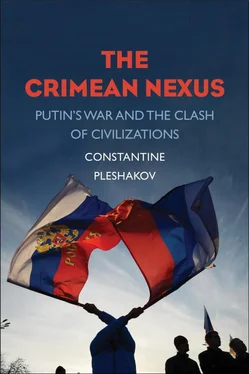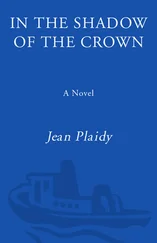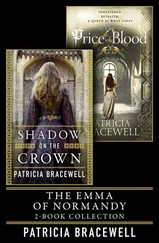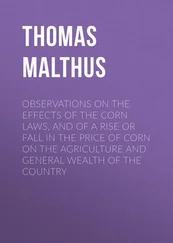One would have thought that on a space like that, great powers would tread carefully. But no such luck.
THREE
A Chain of Unfortunate Events
It will probably never be known with certainty what exactly happened in Kiev in the winter of 2013–2014. Not that information was scarce, but the opposite: there has been too much of it. The sheer number of conflicting uncorroborated sources used by political parties, governments, and media was dumbfounding, and as every digital source—video, photograph, tweet—claimed authenticity and immediacy, it was virtually impossible to resolve conflicts between different angles, perspectives, and tags. When every picture can be invisibly doctored, none can be trusted.
If the warring parties could agree on any interpretation at all, that would be a bare-bones narrative: in the fall of 2013, Ukraine was poised to choose between two economic patrons—Russia and the European Union. Contrary to the wishes of many, the president of Ukraine, Viktor Yanukovych, chose Russia; protests started in Kiev; there were clashes between rioters and government forces, and people on both sides died; Yanukovych fled, and opposition leaders formed a pro-E.U. revolutionary government. Beyond that utterly minimal summary, accord ends.
Elected to the Ukrainian presidency in 2010, the “pro-Russian” Yanukovych was not averse to dallying with the West, and once in office, he continued the precarious East-West “dual vector” balancing act of his predecessors. His cabinet dropped plans to join NATO, but not the intention to intensify cooperation with the European Union. [1] Roxburgh, The Strongman , 259; Vladimir Socor, “Maidan’s Ashes, Ukrainian Phoenix—A Net Assessment of the Regime Change in Ukraine Since the Start of 2014,” Eurasia Daily Monitor , vol. 11, issue 184, October 17, 2014.
The Ukraine–European Union Association Agreement was conceived in 2012. The majority in the Ukrainian Rada (its parliament), including Yanukovych’s party, supported the move. The agreement was to be signed at the E.U. summit on November 29, 2013, in the Lithuanian capital of Vilnius.
At first, Putin applied the stick. In August, Russia changed its customs regulations for Ukrainian goods, causing a 10 percent drop in Ukrainian exports—a hard blow for an already destitute country. But that alone did not deter Yanukovych. What made him change his mind were the finalized figures of Western aid, presented in November. The European Union offered $838 million in loans; the International Monetary Fund $4 billion, provided Yanukovych made budget cuts and raised domestic gas prices by 40 percent. Putin responded with a promise of $15 billion in loans plus $3 billion a year in natural-gas subsidies. On November 21, Yanukovych’s cabinet suspended its deal with the European Union.
An overlooked fact is that no one ever actually offered Ukraine membership in the European Union. Contrary to the beliefs of the pro-E.U. Ukrainians, the “association” would not have given them the rights of unrestricted travel and access to jobs throughout the continent enjoyed by citizens of E.U. nations. For Brussels, the underlying rationale for expanding to Ukraine was to take over a market with 44 million customers. At the same time, Ukrainian agricultural produce, while popular in Russia, did not stand a chance in the heavily regulated European markets. Still, indignant that Yanukovych had made the strategic decision unilaterally, protestors filled the government quarter of Kiev’s Right Bank, along Mykhailo Hrushevsky and Instytutska streets. The largest crowds assembled on Maidan Nezalezhnosti—Independence Square. As the protestors demanded association with the European Union, the movement was dubbed the Euromaidan.
Various sources, referencing different dates, estimated the number of participants anywhere from 50,000 to 800,000. More than half were from western Ukraine.
They were quickly joined by far-right groups vowing to persecute “Ivans and kikes.” Putin’s provocateurs stepped in as well. Rallies turned violent. What had started as a grassroots protest against a “rogue state” developed into something infinitely more complex: an interregional conflict informed by different ideologies, special interests, a shadow economy, and foreign intervention. [2] Andrey Kurkov, “Ukraine’s Revolution: Making Sense of a Year of Chaos,” BBC, November 21, 2014, www.bbc.com/news/world-europe-30131108 (retrieved November 26, 2014).
From Kiev, clashes between revolutionaries and loyalists spread to the provinces. Government buildings were attacked, local administrations overtaken. The Euromaidan groups prevailed in the west, Russophiles in the east.
There is plenty of evidence to support the claim that during his years in power, Yanukovych enriched his own associates at the expense of other oligarchs. There is also evidence of the anti-Yanukovych oligarchs’ deep involvement in the 2013–2014 political overhaul. Petro Poroshenko, known as the Chocolate King for having made his fortune as the owner of a confectionary manufacturer (and who would later become the president of Ukraine), boastfully admitted: “From the beginning, I was one of the organizers of the Maidan. My television channel—Channel 5—played a tremendously important role.” Another oligarch, Dmitry Firtash, claimed to have manipulated both the Euromaidan and Poroshenko. And so on. The events in Kiev would not have been possible without the oligarchs’ participation, but hardly any tycoon had a clear vision of where things should be going, and steered the protests accordingly. [3] “Comrade Capitalism: How Russia Does Business in the Putin Era,” A Reuters Investigation series, www.reuters.com/investigates/special-report/russia/#article-5-the-kiev-connection (retrieved November 26, 2014); Lally Weymouth, “Interview with Ukrainian Presidential Candidate Petro Poroshenko,” Washington Post , April 25, 2014; Shaun Walker, “Ukraine Oligarch Claims US Extradition Request Is Political Interference,” The Guardian , May 5, 2015, www.theguardian.com/world/2015/may/05/ukraine-oligarch-brokered-deal-petro-poroshenko-president-dmytro-firtash (retrieved May 6, 2015).
The same applies to the revolt’s foreign participants.
If Yanukovych’s was a rogue state, U.S. foreign policy in Ukraine in 2013–2014 can only be described as rogue diplomacy. Most certainly without the imprimatur of President Obama, and perhaps even without a silent nod from Secretary of State John Kerry, a group of senior American diplomats allied with bipartisan interventionists in Congress started brokering regime change in Kiev.
The protagonists included assistant secretary of state for European and Eurasian affairs Victoria Nuland, U.S. ambassador to Ukraine Geoffrey R. Pyatt, and Senator John McCain.
McCain was the first prominent American to descend on Kiev to fraternize with the people on the barricades and encourage them to overthrow the democratically elected president. On December 15, 2013, he told Ukrainians that their future was “with Europe,” not Russia: “The free world is with you, America is with you, I am with you. Ukraine will make Europe better and Europe will make Ukraine better.” Speaking to 200,000 rebels in a foreign capital, he said without apparent irony that he wanted to make it clear to “Russia and Vladimir Putin that interference in the affairs of Ukraine is not acceptable to the United States.” What had started as competition over spheres of interest was, in McCain’s telling, turning into a civilizational clash, the forces of light against the forces of darkness. [4] Harriet Alexander and Christopher Miller, “John McCain in Kiev: ‘Ukraine will make Europe better’,” The Telegraph , December 15, 2013, www.telegraph.co.uk/news/worldnews/europe/ukraine/10518859/John-McCain-in-Kiev-Ukraine-will-make-Europe-better.html (retrieved April 2, 2014).
Читать дальше












